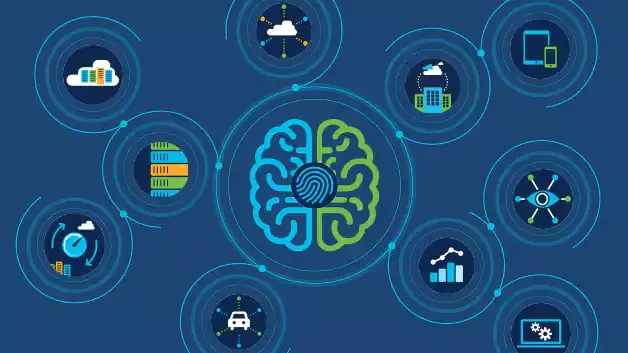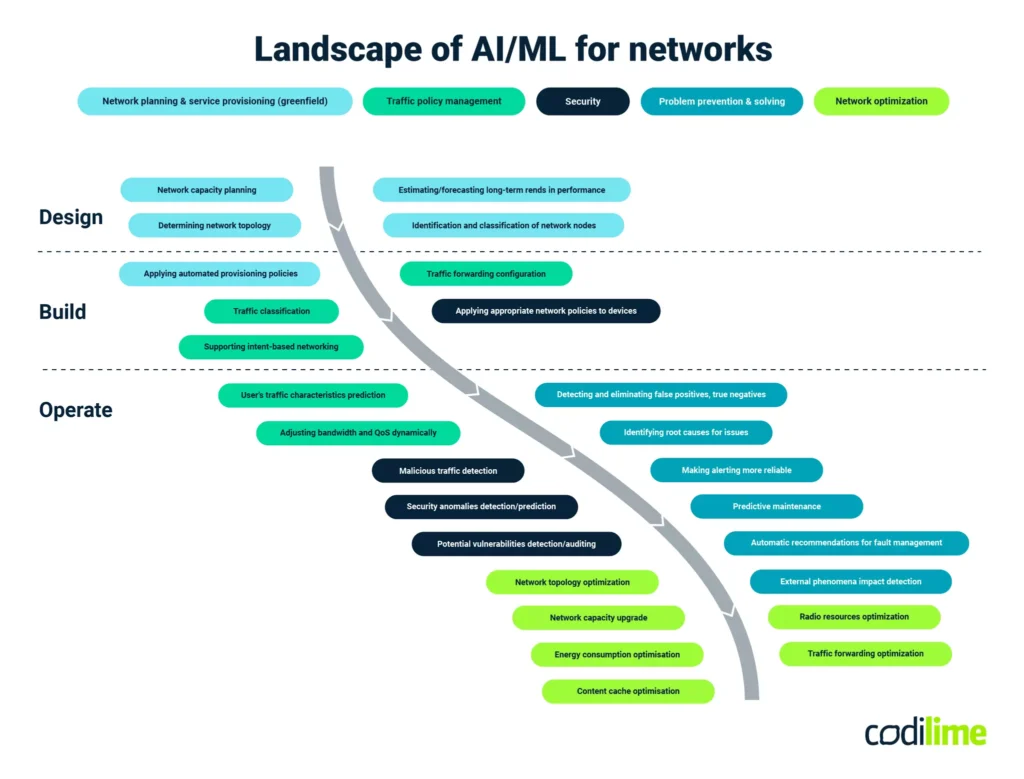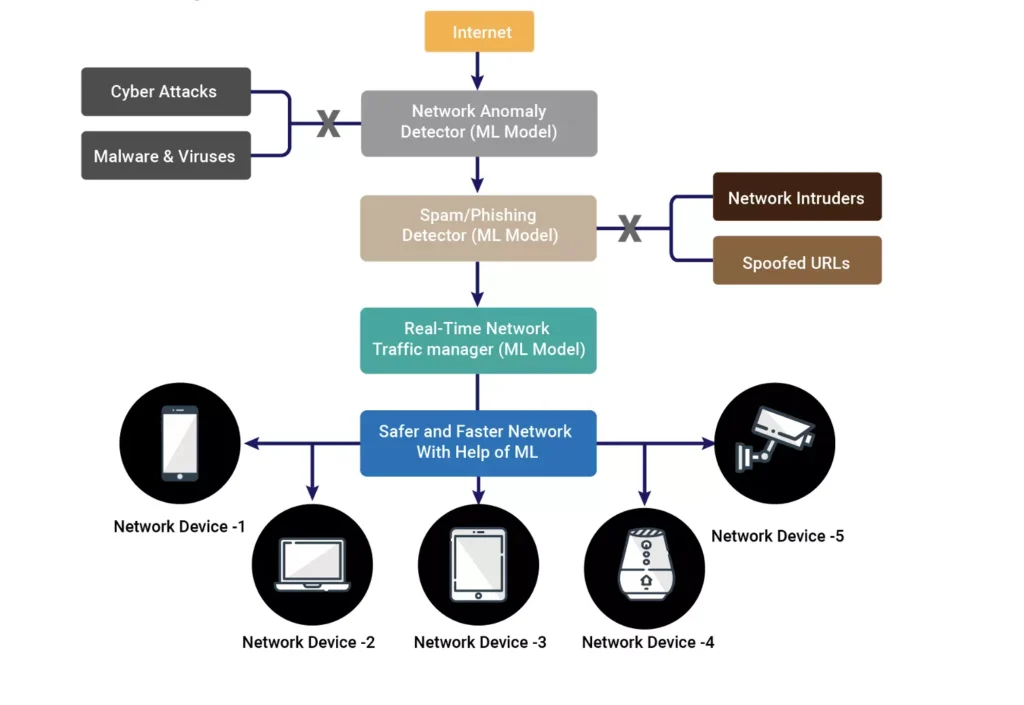
Figure 1: banner
Image source: cisco.com
Integrating AI technology into various products has become a game-changer, particularly in Network Services systems. The definition of AI has expanded to encompass heuristics and probability in programming code, paving the way for more efficient data processing and problem-solving capabilities.
The Machine Learning (ML) market is proliferating globally. In 2022, its value was about $19.20 billion. Experts predict that by 2030, it will skyrocket to a staggering $225.91 billion. This article delves into the profound impact of AI and Machine Learning (ML) in Network Services, shedding light on how they revolutionize the way we handle large amounts of data.
Contents
AI’s Unparalleled Data Management Efficiency
At its core, Artificial Intelligence excels at tackling one of IT’s most significant challenges – efficiently managing vast volumes of data. Through computational speed and human-like heuristics, AI empowers network administrators to identify and resolve issues swiftly. As a part of AI, Machine Learning leverages probabilities to facilitate quick problem recognition, taking Network Services to unprecedented heights.
In 2021, AI in the telecommunications market was worth $1.2 billion worldwide. Experts predict that by 2031, it will grow significantly and reach a staggering $38.8 billion, growing at an impressive rate of 41.4% every year from 2022 to 2031.
AI and ML in Network Services: Key Areas
AI, particularly when combined with Machine Learning, has found its way into the following key areas of Network Services:
1. Traffic Management
ML-based tools have proven to be a game-changer in predicting network traffic patterns. By harnessing the power of neural networks and genetic algorithms, Machine Learning algorithms excel at enhancing pattern-matching capabilities. Inspired by the intricate workings of biological neurons, neural networks process data and identify hidden patterns, enabling accurate predictions of future traffic trends.
AI plays a pivotal role in traffic management through continuous monitoring and incremental adjustments for better traffic shaping. D-Link, for instance, implements immediate, on-switch AI-based traffic management, ensuring efficient network flow control. On the other hand, Cisco adopts an out-of-stream approach, employing AI and ML in network monitoring software for its Catalyst 9000 switches. This approach is better suited for broader solutions and full-capacity planning, making it a flexible choice for network administrators.
2. Performance Monitoring
With AI’s assistance, network administrators can set more accurate performance alert thresholds and gain deeper insights into network efficiency. Leveraging AI and ML, Cisco, Juniper, and third-party tools like LogicMonitor empower network managers with root cause analysis, leading to enhanced network performance and improved traffic analysis.

Figure 2: AI and ML in Networking
Image source: codilime.com
3. Capacity Planning
Capacity planning is another critical aspect of Network Services where AI and ML are making a significant impact. AI-driven capacity planning tools efficiently handle traffic flow simulations and switch performance expectations, ensuring optimal network performance even during high-demand periods.
4. Security Monitoring
One of the most crucial areas where AI shines in Network Services is security monitoring. AI and machine learning are becoming more important in cybersecurity to detect and respond to online threats. Adversaries are using AI too, which is why businesses need to use AI to protect themselves. Companies that don’t use AI in their cybersecurity could face more risks and negative impacts. AI can help organizations handle various risks better, detect problems faster, and adapt to changes in the digital world.

Figure 3: ML in networking
Image source: embeddedcomputing.com
AI enhances Security Information and Event Management (SIEM) by detecting patterns of malicious activity in log files, enabling rapid responses to potential threats. User and Entity Behavior Analytics (UEBA) is a powerful AI-driven tool widely used in cybersecurity, especially in Intrusion Detection Systems (IDS) and Next-generation Anti-virus Systems (NGAV). UEBA eliminates false-positive reporting in Intrusion Prevention Systems (IPS), significantly improving their effectiveness. Additionally, next-generation anti-virus systems utilize UEBA for baseline, identifying viruses the first time they appear on a protected system.
5. AI-Driven Network Planning and Optimization
AI and ML processes are increasingly integral components of competent Network Services tools. These technologies play a pivotal role in creating virtual networks and identifying potential bottlenecks, contributing to the overall success of Network Services activities. ML’s trend analysis and traffic volume tracking implementation further enhance engineers’ ability to optimize network performance.
6. Advanced Analytics: Unraveling Insights for Informed Decision-Making
The infusion of ML in network analytics has opened up a treasure trove of possibilities. ML-driven analytics provide deep insights into traffic trends, empowering network administrators and designers to make informed decisions. Understanding how network usage evolves over time allows for proactive measures in designing efficient and robust networks.
By analyzing historical data, ML algorithms can identify patterns and recurring trends. This knowledge aids in anticipating network requirements, optimizing resource allocation, and planning for future growth.
7. Enhanced Health Monitoring: Pioneering Proactive Network Maintenance
ML-driven health management is akin to having a network doctor on call 24/7. By continuously monitoring network components and performance metrics, ML algorithms can detect early signs of component failure and predict potential issues before they escalate into catastrophic failures.
This proactive approach to network health drastically reduces downtime and maintenance costs. Critical network components can be replaced or repaired before compromising the entire network. With ML as the guiding force, network reliability and uptime reach unprecedented levels, bolstering business continuity and user satisfaction.
Conclusion
The fusion of AI and Machine Learning has revolutionized Network Services, providing network administrators with unparalleled efficiency in data processing, problem-solving, and traffic optimization. AI’s transformative power is reshaping the Network Services landscape, from traffic management and performance monitoring to capacity planning and security. Embracing these cutting-edge technologies will undoubtedly lead to a more robust and secure network infrastructure for organizations worldwide.
STL is leveraging the power of AI and ML in Network Services to empower businesses with smarter, more efficient solutions. By integrating these cutting-edge technologies, STL enables businesses to achieve optimized network performance, enhanced security, and proactive problem resolution, ultimately driving growth and competitiveness in the digital age.
A1. AI-driven network management surpasses traditional methods through real-time data analysis, predictive insights, and automated adjustments. It optimizes network performance, identifies anomalies before they escalate, and enhances efficiency, ensuring proactive and adaptive management that empowers seamless operations in today’s dynamic technological landscape.
A2. AI/ML significantly enhance network scalability and expansion by analyzing data patterns, predicting traffic demands, and optimizing resource allocation. This proactive approach enables efficient provisioning, automatic adjustments, and faster decision-making. As a result, AI/ML-driven networks accommodate growth seamlessly, ensuring optimal performance, minimized downtime, and cost-effective infrastructure development.
A3. AI/ML models learn and adapt to changing network behaviors through iterative processes. Initially, they are trained on historical network data, identifying patterns and relationships. As networks evolve, these models continuously analyze real-time data, comparing it to their learned patterns. Through feedback loops, they adjust their algorithms, fine-tuning predictions and actions. This ongoing adaptation enables AI/ML to anticipate shifts, detect anomalies, and optimize network responses, ensuring optimal performance even in dynamic and evolving environments.
A4. Implementing AI/ML in network services effectively requires a blend of technical resources and expertise. These include skilled data scientists proficient in AI/ML algorithms and frameworks, domain experts in network architecture, and access to substantial historical and real-time network data. Adequate computational infrastructure, including GPUs for efficient model training, is essential. Collaboration between IT teams, data engineers, and domain specialists is crucial to developing, deploying, and maintaining AI/ML models that align with network goals and consistently deliver optimized outcomes.















